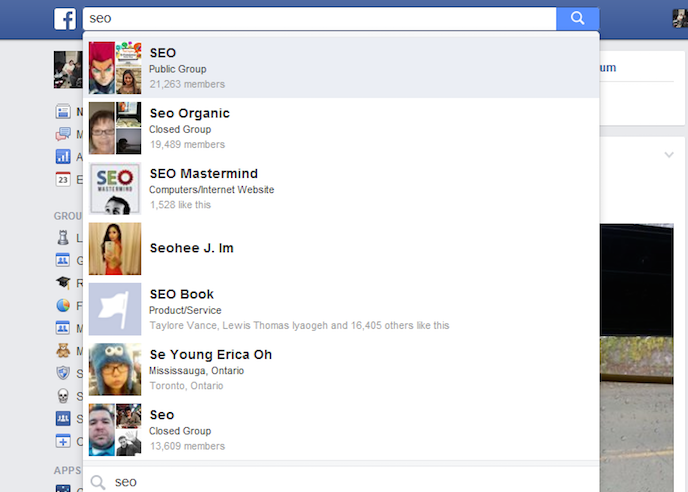Welcome to part 15 of my ultimate series. In today’s series, we’re going to look at how to utilize Facebook groups for driving traffic and potentially obtaining relevant links for other authority bloggers. Facebook.com has always been a great source for content marketing and recently has been an outlet for likeminded people to join groups sharing valuable ideas. Personally, I didn’t use groups until late in my career after I found out how many people are engaging in relevant niche based groups. Here’s a quick outline of the process…
You’ll start by searching relevant targeted groups, joining the largest ones so you can tap into a large audience. Next, you spend 1-2 weeks answering questions, helping newbies, building your reputation. Once you’ve built your reputation, you can start to embed links to relevant content for group members. It’s very easy as long as you follow the protocol and can drive enormous traffic. For example, I did a quick search for a “SEO†related groups and found some with 19,543 members.
Let’s get started

Strategy #15 – Facebook Groups
First, you need to ensure you have a Facebook account. Personally, if you are a blogger and don’t have an account by now, then you’re already losing out on social engagement that generates enormous traffic, etc. Not to mention, opening an account on Facebook.com is FREE and doesn’t cost you a penny unless you’re planning on advertising through their network. Either way, it’s a vital source of traffic and engagement so you should have an account. Start by either logging into your account or joining http://Facebook.com now.
Next,
Type in a search phrase, but make sure it’s relevant to your niche. In the illustration below, I’ve perform a search using the keyword “SEOâ€. It’s important to ignore all the drop-down results generated and click the search icon. View illustration below…

Facebook.com will generate a set of results and you simply have to click “More†and filter by groups. Then you’ll have nothing but a list of niche relevant groups. This search interface is awesome to narrow down exactly what you’re looking for in Facebook groups.
Selecting a Group
Here are a few things to look for when selecting a group…
First, look for the target keyword within the name of the group. It’s great for SEO, but also perfect for growth. People throughout Facebook.com are searching for groups to join and start by targeted their keyword. The more targeted the keyword to your niche, the better potential for growth. Secondly, look for total existing members. I’m currently part of two groups based around “SEO†and both have above 19,000 members. Here’s something else to pay close attention to – The Group Status.
Some are…
- Closed (You can ask for approval by clicking “Join Nowâ€
- Public (no invitation required and open to join)
However, the larger the niche, the more potential of finding large, open groups you can request to join. Next, it’s important, once approved, to skim through the group content being published. Public groups will allow you to view the posts but those requiring approval will NOT allow you to see the content being added. Either way, the requirements are the same when looking for relevant content. For example,
Always look for relevant content to your blog. Find what type of content get “Likes†and have the highest engagement. In one of my groups, I see people sharing “link building strategies†so when I post content, I’ll focus on that type of content to share.
What’s Next?
By this point, you’ve found relevant groups with large members and been approved. It’s a good idea to start engaging, providing tips to members and avoid posting links to your blog. Many group members are aware of people simply joining to post links and you’ll be removed if this becomes a pattern. I write out tips on the wall, avoiding links to build my reputation and for people to start leaving questions so I can answer them. By doing this, I’m slowly building the trust of group members and when I post a link, it’ll be worth more value than the others. Skim through answering questions and posting tips for the first couple of weeks. If you know the niche, then you’ll be an asset and the group will realize your potential.
You can evolve into posting links in the group, providing them with relevant content on your blog. The best content is one that solves a problem. If the group has 20,000 members, then you’ve essentially marketed your content to 20,000 people. Next, some of them are bloggers and will be more than happy to link back to your blog from theirs.
Here’s is a cool strategy to keep track. Use Bitly.com to shorten your link and paste it into the group instead of the direct URL from your blog. This Bitly.com link will keep track when someone clicks through. You’ll have stats on what content gets the highest engagement and going forward, shift your focus on posting this type of content.
